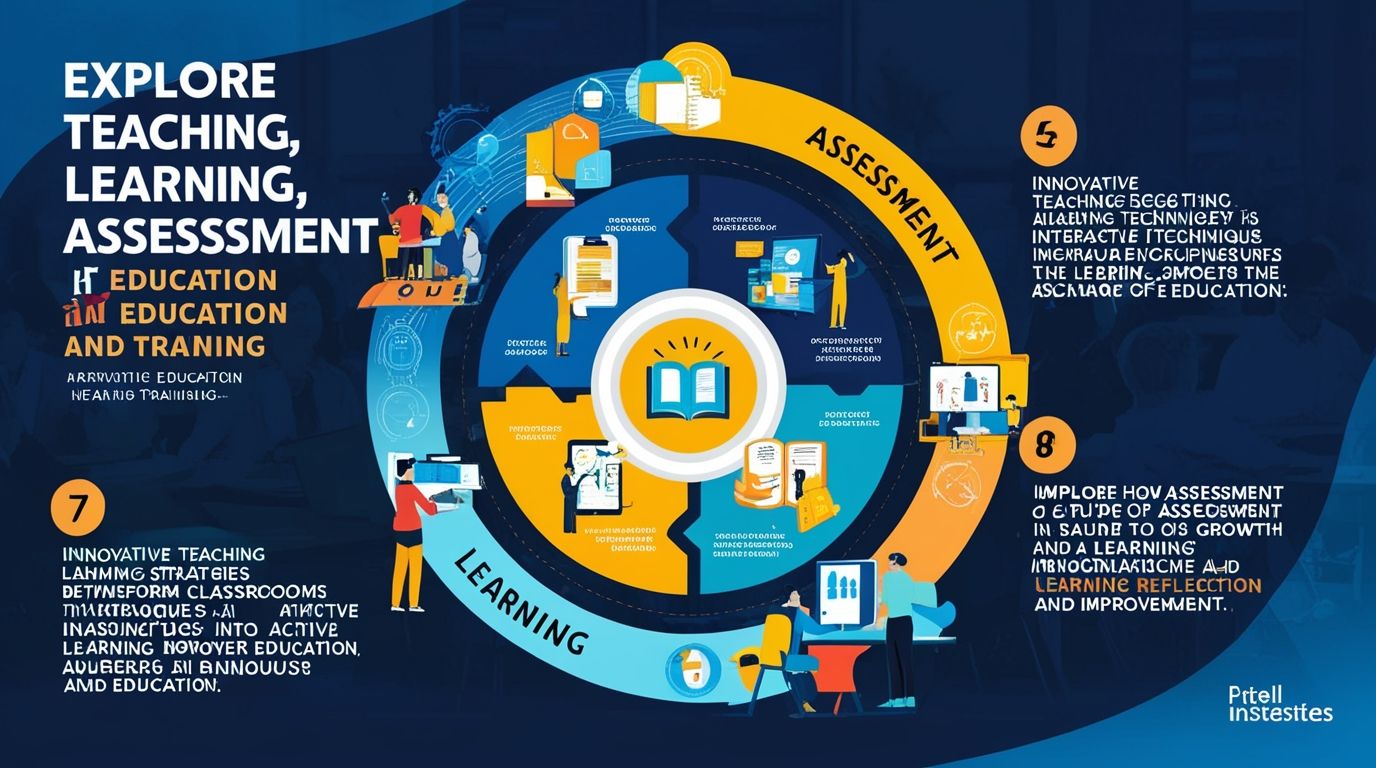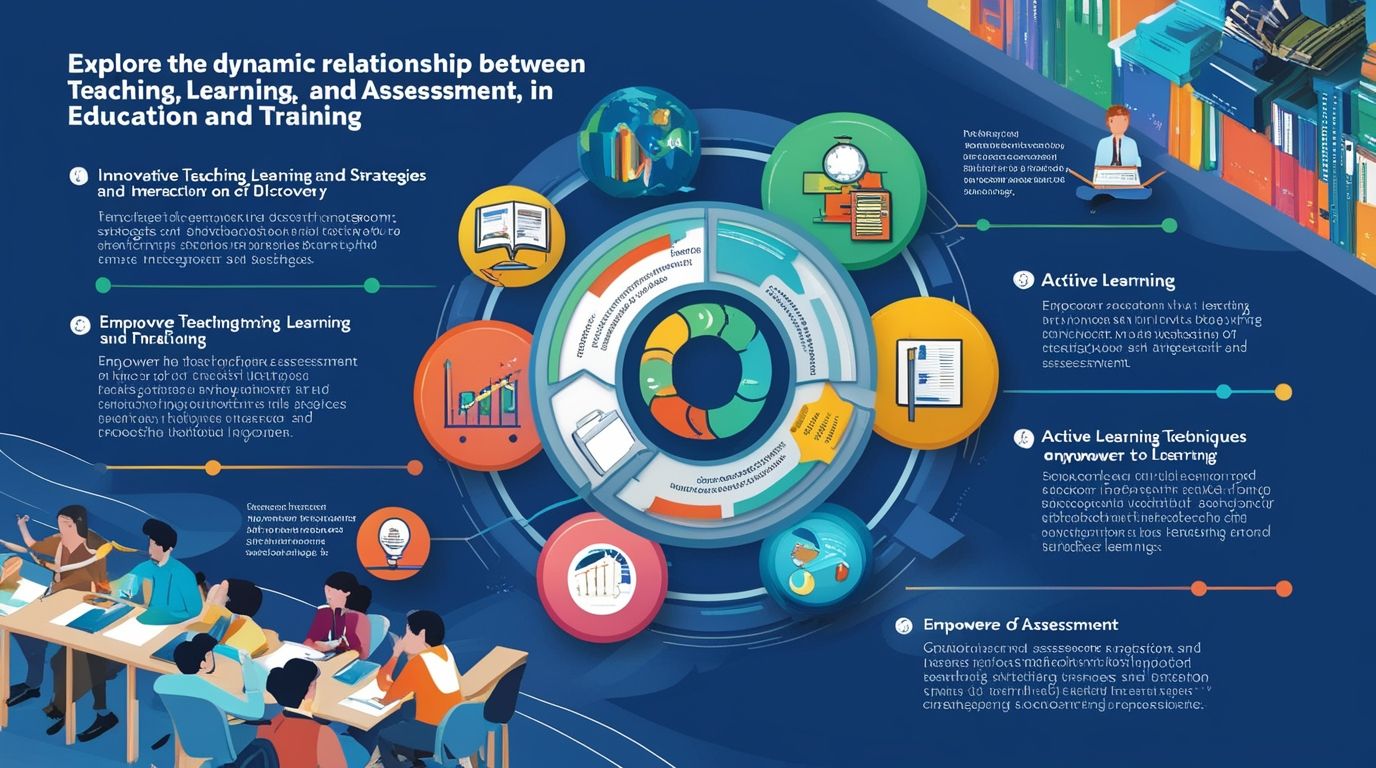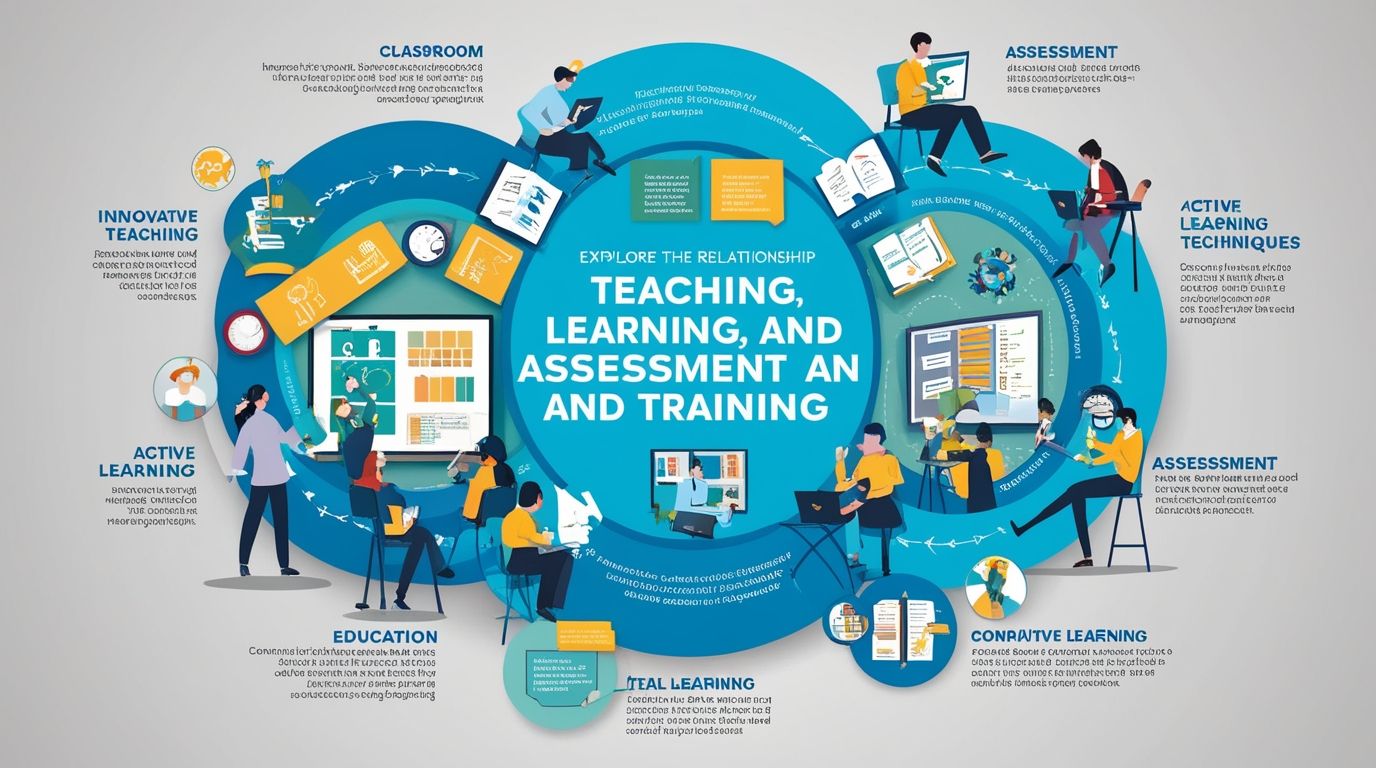Teaching, Learning, and Assessment in Education and Training In the ever-evolving landscape of education and training, the interplay between teaching, learning, and assessment forms the bedrock of effective pedagogy. Each component is intricately linked, influencing and reinforcing the others. To understand the holistic nature of education, it’s crucial to explore innovative strategies that integrate teaching, learning, and assessment in ways that are engaging, reflective, and adaptable to the needs of diverse learners.
The Art of Teaching: Beyond the Traditional Lecture
Teaching has long transcended the boundaries of traditional lecture-based instruction. Today’s educators are called upon to be facilitators, mentors, and innovators, guiding students through a journey of discovery and growth. Effective teaching is characterized by a blend of creativity, empathy, and adaptability, tailored to foster an environment that is conducive to learning.
- 1. Storytelling as a Teaching Tool:
Storytelling is a powerful teaching strategy that can make abstract concepts tangible and relatable. By weaving information into narratives, teachers can capture students’ imagination and make learning memorable. Research shows that storytelling not only enhances comprehension but also boosts retention by engaging multiple cognitive processes (Haven, 2007). - 2. Gamification:
Incorporating elements of game design into the classroom, such as point scoring, leaderboards, and badges, can transform the learning experience. Gamification taps into students’ intrinsic motivation, making learning fun and engaging. It also fosters a sense of competition and accomplishment, which can drive deeper engagement with the material (Deterding et al., 2011). - 3. Flipped Classroom Model:
The flipped classroom model reverses traditional teaching methods by delivering instructional content outside of class, often through videos, and using class time for interactive activities. This approach allows students to learn at their own pace and come to class prepared to engage in hands-on learning, discussions, and problem-solving (Bergmann & Sams, 2012).

Learning: Creating Environments for Active Engagement
Learning is not a passive absorption of information but an active process where students construct knowledge through experience, reflection, and interaction. Effective learning environments are those that are student-centered, fostering autonomy and encouraging exploration.
- 1. Active Learning Techniques:
Active learning shifts the focus from teaching to learning by engaging students directly in the process. Techniques such as think-pair-share, problem-based learning, and case studies encourage students to actively participate and collaborate. Research indicates that active learning improves critical thinking, problem-solving skills, and retention rates (Freeman et al., 2014). - 2. Personalized Learning Paths:
Personalized learning tailors instruction to meet the individual needs of each student, often using technology to adapt content and pace. This approach recognizes that students learn differently and allows them to progress at their own speed. Personalized learning has been shown to increase student engagement and achievement by providing a more relevant and customized educational experience (Pane et al., 2017). - 3. Experiential Learning:
Experiential learning emphasizes learning through experience, allowing students to apply theoretical concepts in real-world contexts. This approach, rooted in Kolb’s Experiential Learning Theory, involves a cycle of concrete experience, reflective observation, abstract conceptualization, and active experimentation. Experiential learning helps bridge the gap between theory and practice, making learning more meaningful (Kolb, 1984).
Assessment: Measuring Learning, Guiding Improvement
Assessment in education and training serves multiple purposes: it measures student learning, provides feedback, and guides instructional decisions. Effective assessment practices are those that are fair, transparent, and aligned with learning objectives. They not only evaluate student performance but also enhance the learning process itself.
- 1. Formative Assessment:
Formative assessment, conducted during the learning process, provides real-time feedback to both students and educators. It allows teachers to identify areas where students are struggling and adjust instruction accordingly. Techniques such as quizzes, one-minute papers, and exit tickets can be powerful tools for gauging understanding and guiding learning (Black & Wiliam, 1998). - 2. Authentic Assessment:
Authentic assessment evaluates students’ ability to apply their knowledge and skills in real-world contexts. This can include projects, presentations, portfolios, and simulations. Authentic assessments are valuable because they reflect actual learning and provide meaningful insights into students’ abilities beyond standardized testing (Mueller, 2005). - 3. Peer and Self-Assessment:
Involving students in the assessment process through peer and self-assessment encourages reflection and critical thinking. By evaluating their own work or that of their peers, students gain a deeper understanding of the criteria for success and develop self-regulation skills. Studies have shown that peer and self-assessment can enhance learning outcomes by promoting a deeper engagement with the content (Falchikov & Goldfinch, 2000).
Integrating Teaching, Learning, and Assessment: A Holistic Approach
The most effective educational environments are those where teaching, learning, and assessment are seamlessly integrated. This holistic approach recognizes that these elements are not isolated but interconnected, each reinforcing and enhancing the others.
- 1. The Reflective Practitioner:
Educators who adopt a reflective approach continuously evaluate their teaching strategies, seek feedback, and adjust their methods to meet the needs of their students. Reflection allows teachers to connect theory with practice, develop professionally, and improve their effectiveness (Schön, 1983). - 2. Feedback Loops:
Creating feedback loops between teaching, learning, and assessment can significantly enhance the educational experience. For example, formative assessments provide feedback that can inform teaching adjustments, while reflective activities help students internalize feedback and apply it to their learning. This iterative process creates a dynamic and responsive learning environment (Hattie & Timperley, 2007). - 3. Technology Integration:
The use of technology can facilitate the integration of teaching, learning, and assessment. Digital tools like learning management systems, online quizzes, and educational apps provide opportunities for continuous assessment, personalized learning, and innovative teaching methods. Technology also enables data-driven decision-making, allowing educators to track progress and adjust instruction based on real-time analytics (Bebell & O’Dwyer, 2010).

Challenges and Opportunities
While the integration of teaching, learning, and assessment presents many opportunities, it also comes with challenges. Educators must navigate diverse student needs, technological advancements, and evolving educational standards. Moreover, the shift towards more student-centered and active learning models requires significant changes in mindset and practice.
However, these challenges also offer opportunities for growth and innovation. By embracing a holistic approach, educators can create learning environments that are not only effective but also engaging, inclusive, and adaptable to the needs of all students.
Conclusion
The synergy between teaching, learning, and assessment is the cornerstone of effective education and training. By adopting a holistic approach that integrates innovative teaching strategies, active learning techniques, and meaningful assessments, educators can foster an environment where students thrive. The goal is not merely to impart knowledge but to inspire curiosity, cultivate critical thinking, and equip learners with the skills they need to succeed in an ever-changing world.
As education continues to evolve, the challenge lies in embracing new methodologies while staying true to the core principles of effective teaching and learning. By focusing on the holistic integration of teaching, learning, and assessment, educators can rise to this challenge and create transformative educational experiences for all learners.
References
- Bebell, D., & O’Dwyer, L. M. (2010). Educational outcomes and research from 1:1 computing settings. The Journal of Technology, Learning, and Assessment, 9(1).
- Bergmann, J., & Sams, A. (2012). Flip your classroom: Reach every student in every class every day. International Society for Technology in Education.
- Black, P., & Wiliam, D. (1998). Assessment and classroom learning. Assessment in Education: Principles, Policy & Practice, 5(1), 7-74.
- Deterding, S., Dixon, D., Khaled, R., & Nacke, L. (2011). From game design elements to gamefulness: Defining “gamification”. Proceedings of the 15th International Academic MindTrek Conference: Envisioning Future Media Environments.
- Falchikov, N., & Goldfinch, J. (2000). Student peer assessment in higher education: A meta-analysis comparing peer and teacher marks. Review of Educational Research, 70(3), 287-322.
- Freeman, S., et al. (2014). Active learning increases student performance in science, engineering, and mathematics. Proceedings of the National Academy of Sciences, 111(23), 8410-8415.
- Hattie, J., & Timperley, H. (2007). The power of feedback. Review of Educational Research, 77(1), 81-112.
- Haven, K. (2007). Story proof: The science behind the startling power of story. Libraries Unlimited.
- Kolb, D. A. (1984). Experiential learning: Experience as the source of learning and development. Prentice Hall.
- Mueller, J. (2005). Authentic assessment toolbox: Enhancing student learning through online faculty development. Journal of Online Learning and Teaching, 1(1).
- Pane, J. F., et al. (2017). Does personalized learning improve student learning more than other approaches? Educational Researcher, 46(5), 234-239.
- Schön, D. A. (1983). The reflective practitioner: How professionals think in action. Basic Books.

6 thoughts on “Teaching, Learning, and Assessment in Education and Training”
Comments are closed.